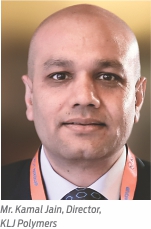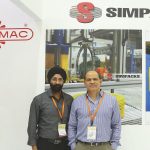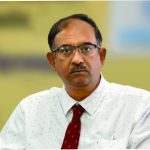“Our new projects includes launch of a new range of EPR, XLPO and ZHFR compounds to strengthen our existing portfolio of such compounds. We are also working on augmenting our semicon offerings with a broad range of bonded and strippable compounds for thermoplastic as well as thermoset applications. We are also developing solar cable compounds which will meet international/national specification,” says Mr. Kamal Jain, Director, KLJ Polymers.
 KLJ, incorporated in 1967, is the market leader in plasticizers and polymer compounds in South Asia. With its ultra modern manufacturing facilities at Silvassa and Bharuch in India, and at Rayong in Thailand, KLJ now is in an advanced stage of setting up an ultra-modern Chlor-Alkali plant in Qatar- expected to be upstream soon. The project is in its final stage of commissioning, and the production should commence from the first half of 2018.
KLJ, incorporated in 1967, is the market leader in plasticizers and polymer compounds in South Asia. With its ultra modern manufacturing facilities at Silvassa and Bharuch in India, and at Rayong in Thailand, KLJ now is in an advanced stage of setting up an ultra-modern Chlor-Alkali plant in Qatar- expected to be upstream soon. The project is in its final stage of commissioning, and the production should commence from the first half of 2018.
Wire & Cable India recently talked to Mr. Kamal Jain, Director, KLJ Polymers to know more about new developments at product and process front. Excerpts:
Wire and Cable India: To start with, tell us briefly about your journey to becoming the largest plasticizer and polymer manufacturer in South Asia.
Kamal Jain: KLJ Group made its humble beginning in 1967 with a PVC compounding plant in Delhi. After 18 years of successfully meeting customers’ expectations, it diversified into manufacturing of plasticizers in 1985 in Delhi. Based on the market acceptance, within 5 years of the launch of plasticizers, it added further capacities in manufacturing of plasticizers by starting a new production facility at Daman in 1990. The group then expanded quickly with more capacities at quick succession; 1996 in Bharuch and 1997 in Silvassa. Both the plasticizer plants, at Silvassa and Bharuch, have been witnessing continuous capacity additions since then. This is the great testimony of the trust, acceptance and reliability that the customers place on us from across the globe. Today KLJ Group is the largest manufacturer of plasticizers in South Asia with widest product basket all across the globe. KLJ Group is one of the largest manufacturers of polymer compounds as well, again with the largest variety of compounds.
During the same period, in 1998, the group expanded its PVC compounding activities at Silvassa. Since 2004, to cater to the requirement of the market for quality and consistency in various markets for different kind of polymer compounds, we started a systemic and structured expansion cum diversification program and over a period of time, have successfully added various polymer compounds in its manufacturing portfolio like XLPE (Sioplas and Peroxide), TPR, TPE, EVA, PP, Semicon, EPR, ZHFR and PO compounds. Currently, the Group is expanding into Engineering Polymer Compounds, where the product will be shortly made available to industries like automotive, appliances and electrical & electronics. In 2016, to cater to the ever increasing demand of its valued and satisfied customers in North India, we also successfully commenced production at a manufacturing facility for TPR Compounds in Delhi.
Around the same time, when we were expanding and diversifying into new polymer compounds, we decided to expand our manufacturing facility abroad. Thus, in 2008, we established a plant for manufacturing Chlorinated Paraffins in Thailand. To maintain our position as global market leader in Chlorinated Paraffins, we are setting up an integrated Chlor-Alkali Complex in a joint venture with QIMC, Qatar, which is likely to commence in first half of 2018. After starting a plant in Thailand, KLJ Group secured No. 1 position globally, becoming the largest producer of Chlorinated Paraffins in the world, and this leadership position will be further augmented once our Qatar facilities become operational. In the current year, i.e., 2017, we have successfully launched benzyl products like benzyl alcohol, benzyldehyde, di benzyl ether, benzyl chloride etc.
WCI: You have manufacturing facilities at Silvassa & Bharuch in India, and at Rayong in Thailand. Would you brief us about the produce you get from these facilities respectively? Do the products from Rayong facility reach India?
KJ: We have two manufacturing facilities at Silvassa; one is for plasticizers (both primary and speciality plasticizers) and another plant is for manufacturing of polymer compounds having capacity of over 100,000 tpa. At Bharuch, we are manufacturing secondary plasticizers and benz products. Total capacity of plasticizers is over 300,000 tpa. Our capacities for plasticizers and compounds are witnessing a regular up-gradation as well as expansions. From these facilities, we are catering to a very delighted customer base all across India as well as overseas. The testimony of our customer focus is the wide acceptance of our products across the globe in over 80 countries. Our Rayong plant mainly caters to customers in South East Asia.
WCI: Being one of the largest plasticizer and polymer makers, which industry does take the biggest pie out of your produce and why?
KJ: We cater to customers across industries like wires and cables, artificial leather, flooring, medical disposables, footwear, packaging, adhesive, perfumery, automotives, paints, appliances, pipes and profiles, irrigation, etc. All segments are important to us. We as a group believes that needs of all segments are equal and deserve undivided attention and hence we have created world class R&D and application labs backed with very strong technical as well marketing team to reach out to the customers proactively. Still, to answer your question, wire and cable would surely be the segment which occupies the biggest share of sale of our products, followed by footwear.
WCI: Coming to your supplies to the wire and cable industry, we are keen to know the applications where your plasticizer and polymers are extensively used. Tell us separately for plasticizer and polymer.
KJ: We have a range of plasticizers comprising phthalate plasticizers, specialty plasticizers, flame retardant plasticizers, ESBO and chlorinated paraffin to meet any current and evolving requirements of our customers in terms of various performances like service temperature, regulatory compliances, service environment, etc. Our polymer compound products range for wire and cable industry covers PVC compound, sioplas PE insulation compound (XLPE – up to 33 KV), peroxide PE insulation compound (for CCV Line – up to 33 KV), semi conductive compound (for HV Cable up to 33 KV), EPR compound (up to 11 KV), ZHFR compounds (up to 40 LOI), Polyolefin compound (HDPE/MDPE/LDPE), and a range of color and functional master batches (PVC/PE/Universal).
The range of industries that we serve with our quality cable compounds range from automotives (T2, T3, VDE, FLRY, VDE, molding, profile, etc.), power cables (PVC, XLPE, Peroxide, ZHFR), domestic wires (FR, FRLS, ZHFR), specialty cables (EPR, ZHFR etc). We also offer a big and comprehensive range of our polymer compound meeting customer specific requirements as well any regulatory compliance.
Our new projects includes launch of a new range of EPR, XLPO and ZHFR compounds to strengthen our existing portfolio of such compounds. We are also working on augmenting our semicon offerings with a broad range of bonded and strippable compounds for thermoplastic as well as thermoset applications. We are also developing solar cable compounds which will meet international/national specification. We hold customer feedback in very high esteem and are open to develop to work on any feasible and technically challenging requirement of our esteemed customers. From commodity market to niche applications, we have it all in our comprehensive range of products and if we do not have it, we are very happy to listen to the customer/market and work proactively to meet the expectations by offering customized solution.
WCI: Compounding remains one of the most dynamic segments wherein it does not take much time for a compound to become obsolete. What do you do to stay relevant in this fast changing demand scenario regarding polymers and compounds?
KJ: As the question deliberates the issue of fast changing situation, the only way to stay relevant is to adapt to the changes with a customer centric R&D facilities. R&D is not the only solution. There has to be a great team working behind the curtains, and also working with the customers. With this belief, we have invested in state-of-the-art facilities for our R&D and application labs as well in our production facilities. We have three R&D facilities, spread across 45,000 sq. ft., dedicated to different segments of our compounding business, with each one dedicated to PVC compounds, XLPE compounds (XLPE, ZHFR, PO, EPR etc) and third one for the other compounds (PP, TPR/TPE and EVA). Expanding these facilities is a way of life with to keep ourselves updated and ahead as leaders in our chosen areas.
Our R&D facilities include the advanced testing machines as well the application machineries like extrusion and molding facilities for cable, strip, tube, soles, etc. We have invested heavily in state-of-the -art equipment in addition to equipment for routine tests. Needless to say that the backbone of any R&D set up is the people behind it. We have a very strong, qualified and dedicated team of scientists and doctorates to run our R&D facilities. We have almost 70 persons working in our testing and R&D facilities. All working to meet and exceed customers’ expectations, with the help and support of the advanced facilities created with the strong and long term vision of the management. Our R&D facilities are even recognized by Department of Science & Technology, Government of India. We are further augmenting these facilities with skilled personnel and an investment of Rs.7 to 8 Cr in next 1-2 years.
As market leader, our goal is to continue to offer products that offer the best value to the customers in terms of quality, economics, and technical support by continuously working to improve our capabilities and communication.
WCI: Most of the compounding industry keeps facing the heat of environmental regulations. How does KLJ perform or strive to perform on these environmental fronts?
KJ: Our focus and investment in R&D assets, in terms of infrastructure and people, helps us to understand and meet any such existing and emerging regulatory challenges. We work with the industry to cater to their performance requirements keeping all the required environmental regulations in mind. We even work to meet regulatory requirements of the future. One example is the current availability of many compounds to meet the proposed RoHS regulations that would come into effect in 2019.
WCI: Your chlor-alkali plant in Qatar was supposed to be upstream by 2016. What is the status and where one does find the usage of chlor-alkali?
KJ: Due to certain regulatory changes at the local level, we had to realign our projects causing some delays. We are happy to confirm that after all the changes, the project is in final stages of commissioning, and we are looking forward towards production to commence in the first half of 2018.
Various products from the project are aimed at different markets. Caustic soda is used in the extraction of aluminium from bauxite, during the manufacturing process of pulp/ paper, soaps and detergent, drain cleaners etc. Chlorinated paraffin is used in many industries like wire and cable, metal working fluids, lubricants, etc. and would help us to grow further from our global market leadership position as largest manufacturer. Hydrochloric acid is used in a variety of applications like leather processing, purification of common salt, oil well drilling, household cleaning agents, manufacturing of organic and inorganic compounds, water treatment chemicals etc. Similarly, our other products like calcium chloride, sodium hypochlorite, also find a wide range of application across industries.
WCI: Tell us something about the project related to Benzyl Alcohol, Benzaldehyde and its derivatives, which was commissioned two years back. Also, brief us about the targeted industries and applications for your new chemistries.
KJ: With the ever expanding market horizons, the need to diversify product portfolio can’t be ignored. Having abundant experience in handling toluene and chlorine, KLJ Group has diversified into manufacturing of wide range of benz products of consistent quality and reliable performance in its state-of-the-art plant, located in Bharuch, Gujarat. We have started, in 2016, a world class plant with an installed capacity of 15,000 tpa. The products have had a very strong acceptance in the international market resulting in the plan for expansion to 30,000 tpa by next year. The plant is equipped with dedicated lines to produce compliant benz products like benzyl alcohol, benzaldehyde, benzyl chloride, sodium benzoate, Di benzyl ether, etc. The plant is strategically located very close to a Chlor-Alkali Plant ensuring consistent supply of chlorine through pipe line enabling us to assure consistent supply to our customers. Our product range finds wide usage in various applications like pesticides, pharmaceuticals/drug intermediates, paints and inks, dyes and inks, perfumery, soaps and flavors etc.




